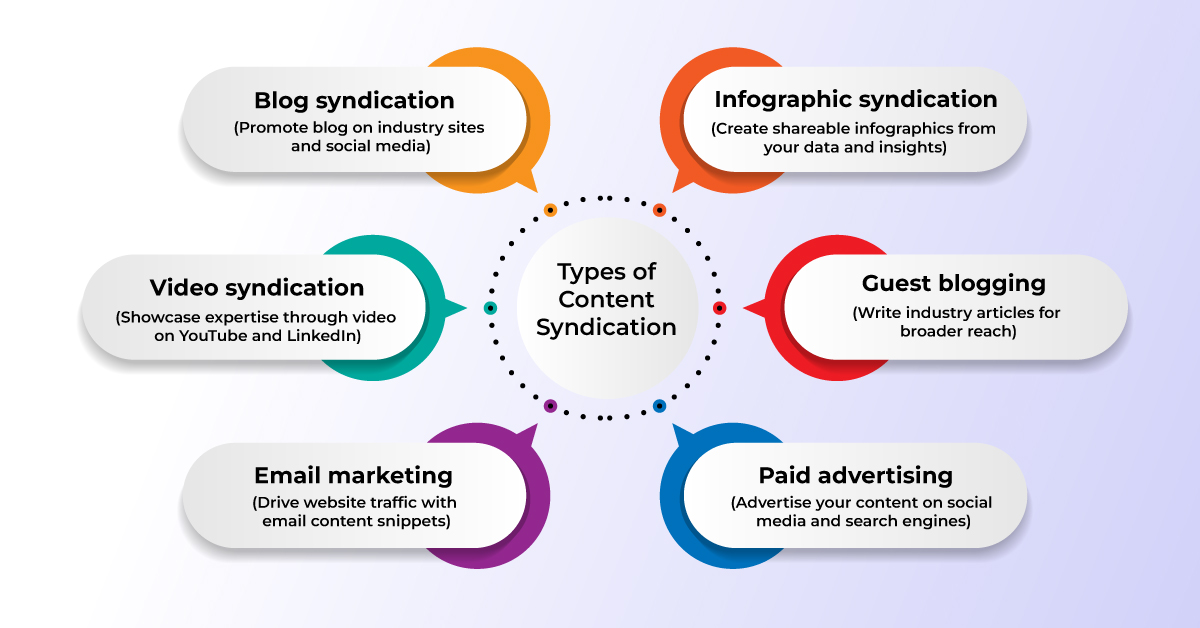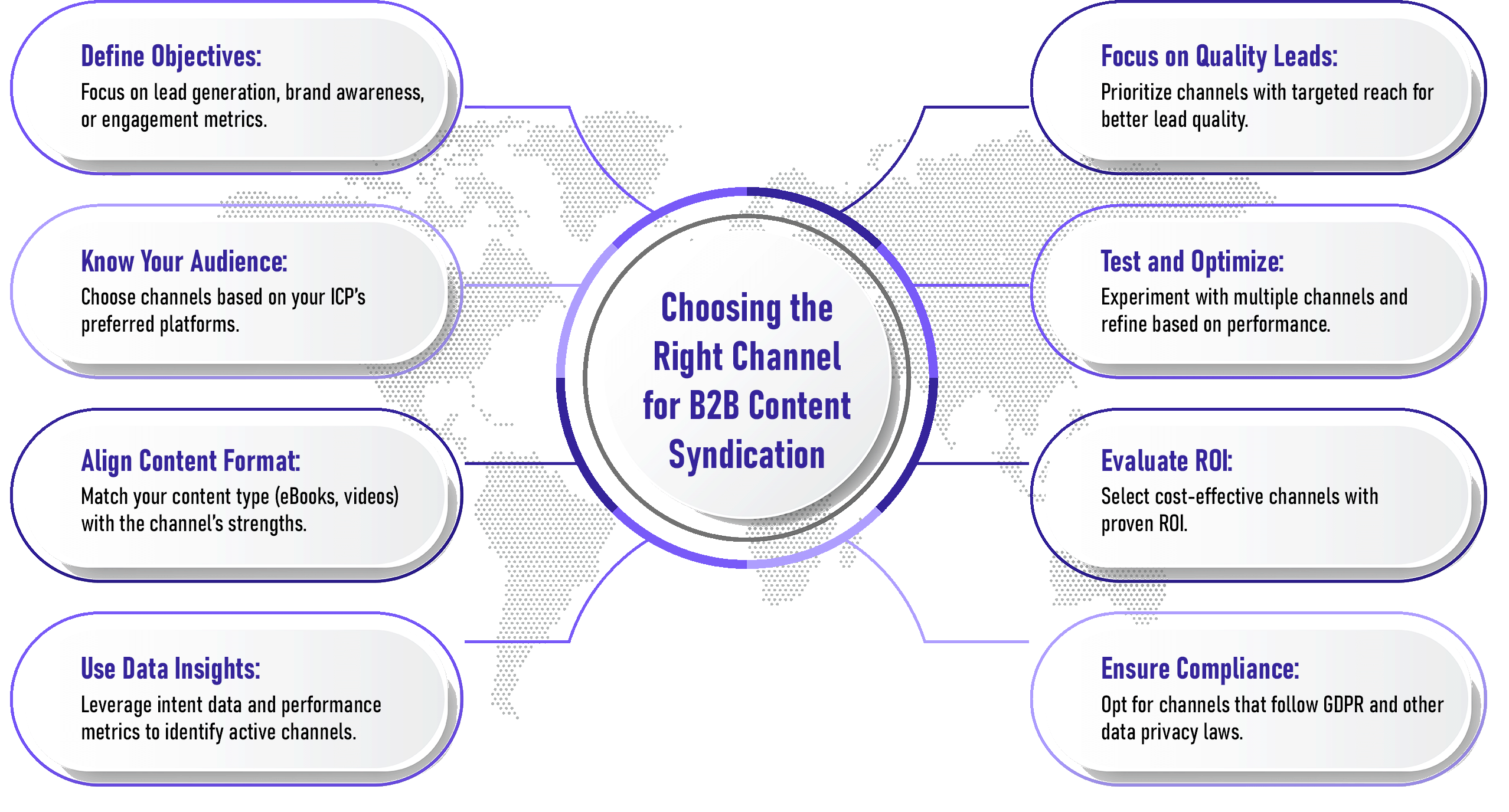Content syndication is set to play a key role in effective marketing strategies. However, generating quality leads with content remains a top challenge among today’s marketing challenges.
Marketers often struggle to create demand for their content. Identifying the right channels for your content is increasingly important to drive marketing return on investment (ROI).
This guide explains various types of B2B content syndication to drive leads through content marketing.
What is Content Syndication?
B2B content syndication refers to distributing content—blogs, infographics, eBooks, and videos—via third-party channels and platforms.
Unlike simply reaching an untargeted audience for broader reach, B2B content syndication focuses on high-quality lead generation and improved ROI.
As B2B client preferences shift toward remote and digital engagement, content syndication is becoming an increasingly integral part of effective B2B marketing.

What are the Types of B2B Content Syndication?
Here are types of B2B channels you should know:
Inbound Channels
Industry-specific publications and blogs are believed to be great sources by a professional audience actively seeking insights. Now, let’s explore how these inbound channels can be powerful allies in your B2B content syndication strategy:
1. Industry Publications and Blogs
Publishing content on credible platforms like Medium and Industry Dive is simple. But many marketers are struggling to find platforms that align with their audience.
Syndicating on industry-specific platforms enhances credibility and positions your brand as a thought leader.
This way, you can cater to a professional audience that is actively seeking industry trends, insights, and thought leadership.
2. Social Media Networks
Does social media work for B2B? Of course, it does.
This is why 89% of B2B marketers use LinkedIn for lead generation. Unfortunately, there is still a misconception that social media works only for awareness and not lead generation. In fact, research found that social media supports the buying decision.
Social media is effective only when you syndicate content on the right platform. That’s because each network caters to unique user behaviors and preferences. For example, LinkedIn works well for whitepapers or case studies targeting professionals, while Facebook Groups might be better suited for infographics tailored to specific industries.
By tailoring your content format to match the platform’s audience, you ensure better engagement.
3. Content Aggregation Platforms
Content aggregation platforms like Outbrain and Taboola use sophisticated algorithms to recommend your content to users who are likely to be interested in it. These platforms can significantly widen your content’s reach, driving more traffic and potential leads to your website.
4. Community Sharing Platforms
Community engagement only benefits awareness, not lead generation. Not really. With thoughtful engagement, you can position your brand as a trusted authority, driving leads over time.
Community sharing platforms like Reddit, Quora, and niche forums allow you to share your content with communities that are specifically interested in your industry, enhancing the chances of lead generation.
These platforms bridge the gap between your content and potential leads, ensuring visibility and engagement.
You can share case studies, success stories, or practical tips relevant to the community’s needs. Engaging directly with potential leads by answering their questions and providing actionable advice can be more effective.
Now, let’s shift our focus to outbound channels, exploring how guest blogging, email marketing, and paid content syndication can amplify your content syndication efforts.
Outbound Channels
1. Guest Blogging
Guest blogging is alive and thriving. It remains a trusted method for expanding audience reach and establishing thought leadership.
Some believe that guest blogging has lost its relevance due to changes in search engine algorithms and content saturation.
However, guest blogging remains viable when executed correctly. Focus on high-quality, original content for reputable platforms that align with your industry.
2. Email Marketing
Email marketing is a traditional yet effective channel for content syndication. Contrary to this belief, email marketing continues to deliver a high return on investment (ROI).
According to HubSpot, email generates $36 for every dollar spent, making it a highly effective marketing channel.
To maximize its potential, focus on building a quality subscriber list and crafting personalized, relevant content.
When executed correctly, email marketing drives impressive ROI. You must focus on providing valuable, informative content that addresses the specific challenges and needs of your business audience.
3. Paid Content Distribution
Paid content distribution through native advertising networks can be an effective way to promote your content to a specific audience. When dealing with financial content, leveraging financial content syndication best practices can further enhance visibility and engagement.
While this requires a financial investment, the returns in terms of targeted reach and lead generation can be substantial.
To get better ROI, focus on precise targeting, high-quality content, and selecting the right platforms. Use analytics to assess performance and adjust strategies accordingly.
Must Read: Content Syndication vs. Guest Blogging Which is Better for Your Brand

Choosing the Right Channel for Your B2B Content
1. Content Type Matching
Different content formats resonate differently with audiences. For instance, case studies may be more effective on professional platforms like LinkedIn, while infographics might perform better on visual platforms like Facebook. Aligning your content format with the most suitable channel is crucial for maximizing engagement.
2. Target Audience Focus
Understanding your ideal customer profile can guide your channel selection. If your target audience frequents a particular platform, it makes sense to prioritize that channel for content syndication.
3. Budget and Resource Considerations
Each channel requires a different level of investment in terms of time, effort, and sometimes, money. Analyzing the cost-effectiveness and effort required for each channel can help you make an informed decision.
Now, let’s delve into advanced strategies that can take your B2B content syndication efforts to the next level.
Advanced B2B Content Syndication Strategies
1. Repurposing and Optimizing Content
Repurposing existing content for different channels and formats can extend your content’s reach without the need for creating new content from scratch. This could involve turning a blog post into an infographic or a webinar into a series of blog posts.
2. Tracking and Measuring Performance
Analytics tools play a crucial role in understanding content syndication effectiveness, guiding strategic optimization.
Utilizing analytics tools can provide valuable insights into your content syndication efforts. These insights can guide your content strategy, helping you understand what works and what doesn’t, and enabling you to measure content syndication campaigns accordingly.
3. Building Lasting Partnerships
Developing long-term relationships with syndication partners can provide consistent exposure to a wider audience. These partnerships, based on mutual benefit, can lead to increased brand visibility and lead generation.
Conclusion
A solid content syndication strategy can help marketers generate more leads, boost brand awareness, and improve SEO rankings. Aligning the right type of content syndication with the targeted audience can significantly enhance your return on investment.
You have the option to develop your own content syndication plan or collaborate with vendors to acquire high-quality leads for your sales team, thereby driving conversions.
Must Read: Automate Your Content Syndication or Risk Falling Behind




